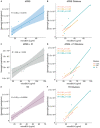Comparison of Methods for Quantifying Extracellular Vesicles of Gram-Negative Bacteria
- PMID: 37894776
- PMCID: PMC10606555
- DOI: 10.3390/ijms242015096
Comparison of Methods for Quantifying Extracellular Vesicles of Gram-Negative Bacteria
Abstract
There are a variety of methods employed by laboratories for quantifying extracellular vesicles isolated from bacteria. As a result, the ability to compare results across published studies can lead to questions regarding the suitability of methods and buffers for accurately quantifying these vesicles. Within the literature, there are several common methods for vesicle quantification. These include lipid quantification using the lipophilic dye FM 4-64, protein quantification using microBCA, Qubit, and NanoOrange assays, or direct vesicle enumeration using nanoparticle tracking analysis. In addition, various diluents and lysis buffers are also used to resuspend and treat vesicles. In this study, we directly compared the quantification of a bacterial outer membrane vesicle using several commonly used methods. We also tested the impact of different buffers, buffer age, lysis method, and vesicle diluent on vesicle quantification. The results showed that buffer age had no significant effect on vesicle quantification, but the lysis method impacted the reliability of measurements using Qubit and NanoOrange. The microBCA assay displayed the least variability in protein concentration values and was the most consistent, regardless of the buffer or diluent used. MicroBCA also demonstrated the strongest correlation to the NTA-determined particle number across a range of vesicle concentrations. Overall, these results indicate that with appropriate diluent and buffer choice, microBCA vs. NTA standard curves could be generated and the microBCA assay used to estimate the particle number when NTA instrumentation is not readily available.
Keywords: FM 4-64; NTA; NanoOrange; Qubit; bacterial extracellular vesicle; microBCA; nanoparticle tracking analysis; outer membrane vesicles; vesicle quantification.
Conflict of interest statement
The authors declare no conflict of interest.
Figures




Similar articles
-
Considerations for the Analysis of Bacterial Membrane Vesicles: Methods of Vesicle Production and Quantification Can Influence Biological and Experimental Outcomes.Microbiol Spectr. 2021 Dec 22;9(3):e0127321. doi: 10.1128/Spectrum.01273-21. Epub 2021 Dec 22. Microbiol Spectr. 2021. PMID: 34937167 Free PMC article.
-
Improving Reproducibility to Meet Minimal Information for Studies of Extracellular Vesicles 2018 Guidelines in Nanoparticle Tracking Analysis.J Vis Exp. 2021 Nov 17;(177):10.3791/63059. doi: 10.3791/63059. J Vis Exp. 2021. PMID: 34866624 Free PMC article.
-
Enumeration of extracellular vesicles by a new improved flow cytometric method is comparable to fluorescence mode nanoparticle tracking analysis.Nanomedicine. 2016 May;12(4):977-986. doi: 10.1016/j.nano.2015.12.370. Epub 2016 Jan 6. Nanomedicine. 2016. PMID: 26767510
-
Gram-negative and Gram-positive bacterial extracellular vesicles.Semin Cell Dev Biol. 2015 Apr;40:97-104. doi: 10.1016/j.semcdb.2015.02.006. Epub 2015 Feb 19. Semin Cell Dev Biol. 2015. PMID: 25704309 Review.
-
Methods for the physical characterization and quantification of extracellular vesicles in biological samples.Biochim Biophys Acta Gen Subj. 2017 Jan;1861(1 Pt A):3164-3179. doi: 10.1016/j.bbagen.2016.07.028. Epub 2016 Aug 3. Biochim Biophys Acta Gen Subj. 2017. PMID: 27495390 Review.
Cited by
-
Therapeutic potential of mesenchymal stem cell-derived extracellular vesicles: A focus on inflammatory bowel disease.Clin Transl Med. 2024 Nov;14(11):e70075. doi: 10.1002/ctm2.70075. Clin Transl Med. 2024. PMID: 39488745 Free PMC article. Review.
-
Introduction to the Special Issue Dedicated to Extracellular Vesicles and Nanoparticles, Part 1.Int J Mol Sci. 2024 Jul 17;25(14):7805. doi: 10.3390/ijms25147805. Int J Mol Sci. 2024. PMID: 39063047 Free PMC article.
-
Bacterial outer membrane vesicles in the fight against cancer.Chin Med J (Engl). 2024 Sep 20;137(18):2169-2181. doi: 10.1097/CM9.0000000000003234. Epub 2024 Aug 9. Chin Med J (Engl). 2024. PMID: 39118214 Free PMC article. Review.
References
MeSH terms
Substances
Grants and funding
LinkOut - more resources
Full Text Sources
Molecular Biology Databases
Research Materials

